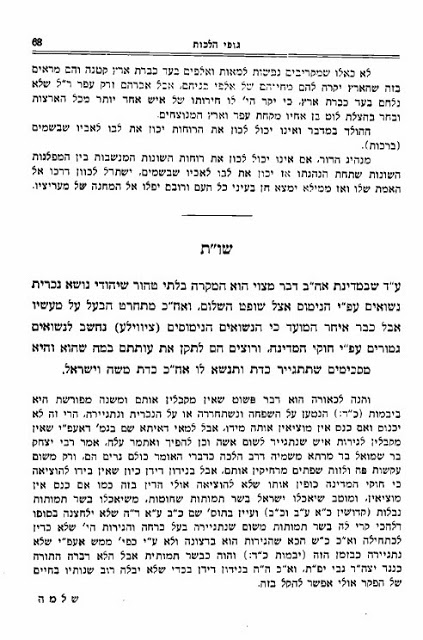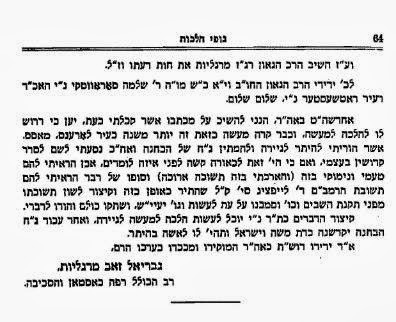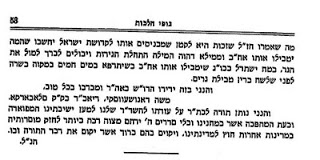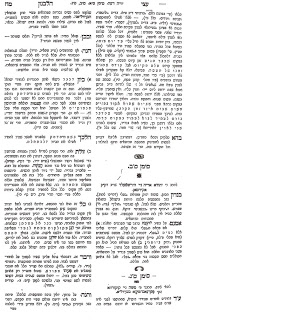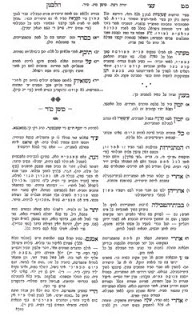Thoughts on Confrontation & Sundry Matters Part I
Soloveichik is currently working on his PhD at Princeton, and due to his many essays he has already made a mark. While it is true that political concerns play a central role in his writing, and he seems most comfortable in the role of public intellectual rather than academic scholar, there is a great deal of learning in everything that he produces. He has also emerged as Orthodoxy’s most prominent “theocon,” which has led him to take positions that in my opinion are at odds with the proper halakhic response.[4] I also suspect that many will not look kindly upon his theoretical defense of torture, although no one can argue the case better than he can.[5]
There are those who will criticize Soloveichik because he engages in theological dialogue with Christians, and they think that this is in violation of the Rav’s strictures. If that were the case, then the Rav himself would be in violation, because he first delivered his famous “Lonely Man of Faith” as a lecture at a Catholic seminary.[6] The fact is that the Rav never said that theological issues couldn’t be discussed with non-Jews in a non-official setting. It all depends on the context of the discussions and the venue. In any event, it is very important to have a rabbi who actually understands Christian dogma. Otherwise, you can get poskim, like R. Joseph Messas, mentioned below, who come to decisions based on entirely incorrect information.
We should all be happy that there is a rabbi who knows that before Newman was an actor and then a tomato sauce, there was a more important Newman, that Immaculate Conception is not Virgin Birth, that Limbo is not only a game played at Bar Mitzvahs, and that St. Thomas is more than an island in the Caribbean. There are, however, many rabbis who know very little about Christianity. That is fine, but it is not fine when they try to speak about a matter they know nothing about. Some time ago I heard a talk in which the speaker gave his take on what was wrong with certain Christian ideas. The only problem was that that he had but a smattering of knowledge of the religion he was discussing. (Can you believe that there are people who speak about Catholicism without even knowing what happened at Vatican II?) After the talk someone asked me what I thought about the speaker. My reply was to quote the immortal words of Ha-Gaon R. Mizrach-Etz: “A man has got to know his limitations.”[7]
Let me begin with a short article I wrote on “Confrontation” that originally appeared on the website of Boston College’s Center for Jewish-Christian Understanding. I don’t think that many people have seen it, and posting it here will give it some more exposure. I would encourage people to also read the other papers.[8] One can even watch the original presentations.[9] “Confrontation”: A Mixed Legacy If any evidence were needed of the centrality of Rabbi Joseph B. Soloveitchik in contemporary American Orthodoxy, one need only look at the vigorous exchange of ideas between Drs. Korn, Berger and Rabbi Klapper. These thinkers have focused on a close reading of the seminal essay “Confrontation,” and have argued about its message and implications in a changed world. I would like to call attention to some points that have not been raised, which I regard as unfortunate results of the widespread acceptance in American Orthodoxy of the perspective offered in “Confrontation.”
My goal in these comments is not to criticize the essay, but rather to clarify its impact. In fact, both in my personal and professional life (with perhaps one exception) I have avoided all venues of interfaith dialogue, and this despite being in my tenth year of teaching at a Jesuit university. I have participated in numerous events where Christians were exposed to Judaism, as well as some where I learnt more about Christianity, but it is unlikely that Rabbi Soloveitchik’s position has any relevance to these situations.
Rabbi Joseph B. Soloveitchik’s warning was directed against Jews dialoguing with Christians in some sort of organized, presumably official,[10] meeting, and the fears he expressed relate to this type of setting. On the other hand, individual Jews and Christians discussing each other’s religion has occurred in every generation, and neither this, nor a Jew giving a lecture to Christians about some aspect of Judaism, qualifies as dialogue of the sort that the Rav was warning against. It is therefore not surprising that even the most strident opponents of dialogue do not mention the subject of Orthodox professors teaching at universities whose student body is primarily Christian.
I have abstained from involvement in interfaith dialogue not because I regard the Rav’s essay as a binding halakhic decision, but because I would have felt uncomfortable being regarded by the other side as a representative of Judaism. (Despite being part of a department of Theology and Religious studies, I am hardly a theologian.) In addition, I have always been sensitive to an aspect of dialogue that the Rav was concerned with, namely, that Jews will feel pressure to adjust their religious views in response to moves from the Christian side. In calling attention to this point, I feel that the Rav was uncannily prescient.
Yet despite the fact that I have lived my life in accordance with the Rav’s guidelines, I believe that his position has had certain negative consequences. It might be that these are the sorts of consequences that Orthodox Jews who follow the Rav’s prescriptions must live with, but I hope not.
One of these consequences is religious separatism, and when it comes to interfaith relations the Modern Orthodox have adopted the same position as that of the right-wing Orthodox. Thus, in the United States one finds virtually no relationships between Modern Orthodox rabbis and Christian clergymen, or between Modern Orthodox groups and their Christian counterparts, even of the sort that the Rav would encourage.[11] This type of separatism is to be expected when dealing with the haredim, but one would have thought that the rabbinic leadership of Modern Orthodoxy would be more open-minded in this area. Yet for many Modern Orthodox rabbinic figures this is not the case, and when a group of Cardinals recently toured Yeshiva University a number of faculty members and students of the Rav expressed strong criticism of the administration in allowing this visit.[12] In fact, the Rav was often cited as a source for this opposition, as if anything he wrote in “Confrontation” spoke against friendly relations and interchange of ideas in non-theological settings.[13]
In today’s Orthodox world, when it comes to Christianity the stress is on the negative, beyond anything the Rav wrote about in “Confrontation.” This has brought about a broad refusal on the part of Modern Orthodox rabbis to have even the barest of relationships with their Christian counterparts. I am not blaming this on “Confrontation,” since before the essay appeared such relationships were also rare, but the essay reinforced the atmosphere of distance between Orthodox Jews and Christians in all spheres, even though this was not its intent. To put it another way, I would say that, despite its intent, “Confrontation” reaffirmed Orthodox Jews’ inclination that, in all but the most negligible circumstances, they should ignore the dominant religion and its adherents. A different essay by the Rav could have put an even greater stress on the positive results of interfaith cooperation in “secular” spheres.[14] Instead, almost nothing was done to remove the fear of Christianity from Orthodoxy, and while in the very shadow of Vatican II this might have been the correct approach, by now I think we have moved beyond this. Yet even in our day it would still be unheard of for a Christian clergyman to address the members of an Orthodox synagogue or group about matters of joint concern. A lay Christian might be welcome, but any relationship with clergy is seen as dangerous, in that it could lead to a compromising of traditional Jewish beliefs.
Another result of the lack of any dialogue between Orthodox Jews and Christians is that in addition to the fear of Christianity, there remains an enormous amount of ignorance. On numerous occasions I have heard Orthodox Jews assert that according to Christianity one must accept Jesus in order to be “saved”. When I have pointed out that this notion has been repudiated by the Catholic Church as well as by most Protestants, the response is usually incredulity.
It is also significant that Orthodox Jews treat Christianity as an abstraction, and detailed discussions about its halakhic status continue to be published. I find it strange, however, that in our post-modern era people can write articles offering judgments about Christianity based solely on book knowledge,[15] without ever having spoken to Christian scholars and clergymen, that is, without having ever confronted Christianity as a living religion.[16] There is something deeply troubling about Orthodox figures discussing whether Christianity is avodah zarah without attempting to learn from Christians how their faith has impacted their lives. I would think that this narrative, attesting as it does to the redemptive power of faith, must also be part of any Jewish evaluation of Christianity.[17] Yet barring theological dialogue, how is this possible?
I realize that the halakhic system prefers raw data to experiential narratives, but certainly modern halakhists and theologians are able to find precedents for inclusion of precisely this sort of information. After all, wasn’t it personal contact with Gentiles, and the recognition that their lives were not like those of the wicked pagans of old, that led to a reevaluation of the halakhic status of the Christian beginning with Meiri and continuing through R. Israel Moses Hazan,[18] R. David Zvi Hoffmann, and R. Jehiel Jacob Weinberg?
The concern with dialogue leading to attempted revisions of traditional Jewish beliefs is certainly well-founded, but the flip-side is that without any direct contact distortions can arise in the other direction as well, namely, in how non-Jews are viewed. Could Saadia Grama ever have written his infamous book[19] if his Gentile neighbor, the Christian, was a real person instead of a caricature? Of course, one does not need interfaith theological dialogue in order to see adherents of other religions in a more positive light than Grama, but as noted above, a current trend opposes even non-theological dialogue. When all substantive contact with the Other is off-limits, it becomes much easier for extremists to reawaken old prejudices that should have no place in a modern democratic society.
I don’t have any illusions that the leaders of American Orthodoxy will change their stance on this matter even after considering what I and others have written. Yet this does not mean that all is lost when it comes to Jewish-Christian relations. Even without theological dialogue there is still a great deal that we can discuss, and thus ensure that neither Orthodox Jews nor Christians are strangers in each other’s eyes. There is a host of social and political issues that affect both of our communities and a vast reservoir of goodwill and respect among Christians for Jews, and Orthodox Jews in particular. Isn’t it time the Orthodox responded in kind?* * *With regard to the Rav and Christianity, it is interesting to note what R. Samuel Volk wrote. R. Volk was one of the other roshei yeshiva at RIETS, an outstanding talmudist who had studied in Telz. Yet he was no fan of the Rav and went so far as to accuse the latter of adopting Christian imagery. In his eulogy for Dr. Samuel Belkin, the Rav described the latter as a wandering and restless yeshiva student. This was too much for Volk (who clearly had a bone to pick with the Rav). In the introduction to volume 7 of his Sha’arei Tohar, he wrote: ראשית כל הנני להעיר שהביטוי הזה של “נודד” שאל “גאון” זה מהגוים ימ”ש, שאומרים שבעבור שעם ישראל לא קבלו תורת “אותו האיש” נתקללו להיות “עם נודד לעולם” ימ”ש וזכרם. ועליהם אין להתפלא דמה לנו ולהם? אבל על “גאון” הנ”ל שיש לו אפי’ “פאספארט” של זכות אבות יש להתפלא! He repeats this criticism of the Rav in his Sha’arei Tohar, vol. 8, p. 332.[20] Yet this is nothing compared to how he savages Dr. Belkin, his former boss. Out of respect for Belkin, I will refrain from reproducing what he writes (which can be found in the just mentioned sources). His words are a good reflection of the conflict and tension that existed between Belkin and the roshei yeshiva, many of whom saw Belkin’s goals as at odds with Torah Judaism[21] On occasion Belkin had to give in to them, as in their threat to resign en masse if he went through with his plan to move Stern College uptown near Yeshiva University. Yet they usually had to sit by and feel growing anger at what they viewed as Belkin’s wrong-headed moves. It was only after they were no longer employed at YU that they could express themselves openly. When they did, it is not surprising that they could be sharper than the most harsh haredi critics. Another strong attack on Belkin was penned by R. Chaim Dov Ber Gulevsky, who also taught at YU. (I will have a great deal more to say about his fascinating writings in one of my upcoming posts.) As with Volk, Gulevsky too, unfortunately, falls into the trap of attacking Belkin personally.[22] In the case of Gulevsky, I can say that he believed that in doing so he was defending the honor of the Rav, for whom he has the greatest respect. Yet, as with Volk, his attack is way overboard, so much so that I am again embarrassed to cite it. It is unfortunate that rather than focusing on all the Torah he taught while at YU, Gulevsky concludes on the following note: ואני תפילה שנזכר לחיים טובים ממלך חפץ בחיים אמן ואמן. ושלא יענישו ושלא ירחיקו אותי ממקורי, וממחיצת צדיקים ישרים ותמימים גאוני ישראל קדושי עליונין בגלל שפעם הייתי במחיצתו של “אותו הנשיא”, “אשר מכף רגל והראש לא היה בו מתום” . . . ר”ל. In Gulevsky’s attack, we also see reflected the long battle between the roshei yeshiva and the adherents of academic Jewish scholarship. This dispute was found at the institution from its early years, and is described in Rakefet’s biography of Revel, Solomon Zeitlin was probably the first focus of the roshei Yeshiva’s anger. A number of others, most notably Irving Agus and Meir Simhah Feldblum, would later run into trouble from the halls of RIETS on account of their outlooks. In Gulevsky’s mind, Belkin was not an adherent of Torah study of the traditional sort – he even denies the well-known story that Belkin received semikhah from the Hafetz Hayyim at age seventeen. He sees Belkin as having sold his soul to the idolatry of academic Jewish studies, with all the heresy that went along with it. In fact, it is not merely academic Jewish studies that Gulevsky sees as Belkin’s downfall, but no less than the hated ‘hokhmah yevanit” that the Sages had warned about. Philo of Alexandria is, in Gulevsky’s understanding, just another example of “hokhmah yevanit.”[23] This involvement with Greek wisdom also led Belkin to his friendships with Christian scholars and “the professor who thought that ‘the Jews made a terrible mistake’ in pushing away oto ha-ish r”l”. Gulevsky told me that (as I suspected) the unnamed professor is Harry A. Wolfson, who was the preeminent Philo scholar of his time. Yet I don’t think Wolfson ever said this, and I believe Gulevsky has confused Wolfson with Joseph Klausner. Gulevsky also recalls with pain how, in his annual shiur in memory of R. Yitzhak Elhanan Spektor, for whom RIETS was named, Belkin would include material dealing with Philo rather than give a traditional shiur. According to Gulevsky, this even led Belkin to make heretical statements with regard to the Oral Law. He also blasts Belkin’s lengthy article on Philo and Midrash Tadshe[24] and what he regards as Belkin’s foolish attempt to posit a Philonic influence on the Zohar through an ancient midrashic tradition.[25] Rather than seeing this last article as a worthy attempt to uphold an ancient dating for the Zohar, Gulevsky instead points out how Scholem rejected Belkin’s position as completely nonsensical, even doing so on a visit to Yeshiva University.[26] * * * Returning to the issue of Judaism and Christianity, let me begin by calling attention to some curiosities that are perhaps not so well known. The first relates to R. Israel Moshe Hazan, mentioned above. His positive view of Christian scholars seemed so over the top to R Eliezer Waldenberg, that the latter delivered a stinging rebuke in Tzitz Eliezer 13:12: שומו שמים למקרא מה יפית כזה לאמונת הנוצרים וחכמיהם מפורש יוצא וללא כל בושה, מפי בעל התשובה . . . ובכלל המותר לקרוא קילוס לחכמיהם? ואיה האיסור של לא תחנם שישנו בדבר? As far as I know, Hazan is the only rabbinic author to publish a Christian haskamah in his work (he actually publishes two). These appear in his Nahalah le-Yisrael, which is devoted to a halakhic problem dealing with inheritance. Translations of these haskamot are found in the appendix to Isadore Grunfeld’s The Jewish Law of Inheritance.[27] (The section dealing with Hazan and his Nahalah le-Yisrael is called: “A Cause Célèbre, A Remarkable Man and a Remarkable Book.”) The Christian scholars’ haskamot appear together with the haskamot of such renowned figures as R. Hayyim David Hazan of Izmir (later Rishon le-Zion in Jerusalem), R. Eleazar Horovitz of Vienna, R. Shimon Sofer of Mattersdorf, R. Avraham Samuel Sofer of Pressburg, and R. Meir Ash of Ungvar. Hazan’s testimony about Jews who would go to the Church to listen the music, even if they stood outside the sanctuary has also been very troubling for many. The whole question of the propriety of entering a church deserves its own post. In years past no Jew would enter a Church unless he was forced to, or in order to avoid enmity. R. Moses Sitrug, Yashiv Moshe, vol. 1, no. 235, discusses the latter case and he advises removing one’s head covering before entering the church. If not, one will be forced to do so in the church, and this would appear as if one was worshipping with the Christians.[28] (When the Chief Rabbi of England is present in a church for an important state function, he does not remove his kippah, and is not expected to.) I began this post with Meir Soloveichik. There was actually another Soloveitchik who also had a great interest in things Christian. I refer to R. Elijah Zvi Soloveitchik. Here is a picture of him.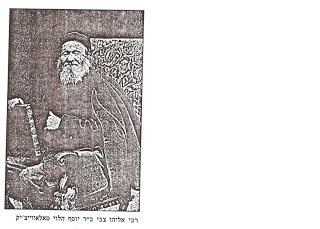
He was the grandson of R. Hayyim of Volozhin and the uncle of R. Joseph Baer Soloveitchik, the Beit Halevi. He is also the subject of a comprehensive monograph by Dov Hyman, who was a medical doctor trained in London and who lived in Manhattan. For some reason this book was kept fairly secret, with only fifty copies published and never sold in stores. Here is the title page of the book.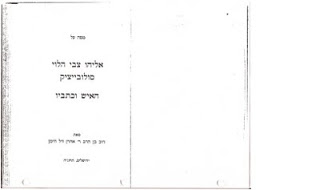 Among Soloveitchik’s works is a volume entitled Kol Kore (Paris, 1875). Friedberg, Beit Eked Seforim, describes this book as “in opposition to the New Testament.” Yet Friedberg never looked carefully at the volume, for if he did he would have seen that rather than being in opposition to the New Testament, it is in favor of it. Yet it is not a missionary tract. Rather, Soloveitchik followed the approach of R. Jacob Emden (whom he cites in his introduction) that the New Testament is only directed towards Gentiles, and supports the Noahide Laws. However, it has nothing to say to Jews, whom it acknowledges are obligated to keep the Torah. In line with this conception, Soloveitchik felt comfortable in authoring a commentary on the book of Matthew, and that is what the Kol Kore is. Here are the title pages of the first edition as well as the 1985 reprint.
Among Soloveitchik’s works is a volume entitled Kol Kore (Paris, 1875). Friedberg, Beit Eked Seforim, describes this book as “in opposition to the New Testament.” Yet Friedberg never looked carefully at the volume, for if he did he would have seen that rather than being in opposition to the New Testament, it is in favor of it. Yet it is not a missionary tract. Rather, Soloveitchik followed the approach of R. Jacob Emden (whom he cites in his introduction) that the New Testament is only directed towards Gentiles, and supports the Noahide Laws. However, it has nothing to say to Jews, whom it acknowledges are obligated to keep the Torah. In line with this conception, Soloveitchik felt comfortable in authoring a commentary on the book of Matthew, and that is what the Kol Kore is. Here are the title pages of the first edition as well as the 1985 reprint. 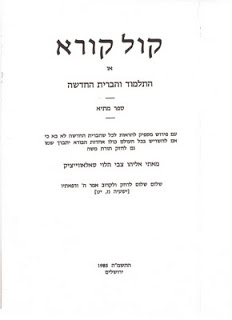
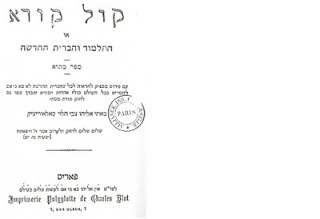 This is not the only rabbinic commentary on the book of Matthew. In 1900 R. Samuel Weintraub’s commentary on this Gospel was published (Milhemet Shmuel). Yet unlike Soloveitchik’s work, Weintraub’s commentary is devoted to exposing the Gospel’s faults.[29] Here are the two title pages of the book.
This is not the only rabbinic commentary on the book of Matthew. In 1900 R. Samuel Weintraub’s commentary on this Gospel was published (Milhemet Shmuel). Yet unlike Soloveitchik’s work, Weintraub’s commentary is devoted to exposing the Gospel’s faults.[29] Here are the two title pages of the book. 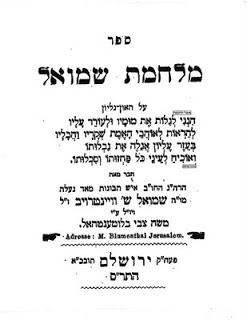
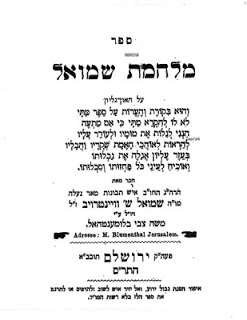 The book is an interesting polemic, which unlike most polemics is written in the form of a commentary. Yet there are times when the author goes too far. For example, he deals with Matthew 1:18, which states that Mary was impregnated by the Holy Spirit. Needless to say, he strongly attacks this notion. But he also has to make sense of Gen. 6:2, which states that “the sons of God saw the daughters of men that they were fair; and they took them as wives.” The problematic words are בני אלהים, as this might be taken to show that the Torah also shares the mythological conception of gods impregnating women. Weintraub writes: הוא כתרגום אונקלס בני רברביא, ואמרו בב”ר ר”ש בן יוחאי הי’ מקלל למי שמתרגם בני אלהיא, כי לא יתכן כלל שהמלאך יבוא אל האשה ויחמוד אותה, ורק העובדי אלילים היו מאמינים בשטותים הללו כמבואר בספרי מיטהאלאגיע ובס’ יוסיפון, תדע שהרי הכתוב מסיים עלה: וירא ד’ כי רבה רעת האדם בארץ, ולא כתיב כי רבה רעת בני אלהים בארץ, כי בני אלהים האמורים היו ג”כ בני אדם כתרגום אונקלס. ואם רצה השי”ת לברא את המשיח ברוח קדשו היה לו לבראו עפר מן האדמה מבלי אב ואם כמו שברא את אדם הראשון ואז היו כולם מודים בו ואין הקב”ה בא בטרוניא עם בריותיו. The only problem with Weintraub’s point is that in his zeal to attack the Christian belief, and by asserting that only pagans could believe in a nonsensical notion such that an angel could desire a woman, he has unknowingly also placed certain rabbinic texts into the category of not simply fools, but עובדי אלילים. Devarim Rabbah 11:10 describes how “two angels, Uzah and Azael, came down from near Thy divine Presence and coveted the daughters of the earth and they corrupted their way upon the earth until Thou didst suspend them between earth and heaven.” Similar passages are found in other rabbinic texts, in particular Pirkei de-Rabbi Eliezer, ch. 22, which elaborates on how the angels desired and impregnated human women. This is part of the whole genre of “fallen angels” stories found in the ancient world. I personally have no doubt that passages such as these are foreign imports, mythological tales that somehow found their way into Jewish literature. Yet precisely because the “fallen angel” genre became part of Jewish tradition, even if one chooses to reject it I think it is going much too far to regard something that appears in traditional rabbinic sources as being idolatrous. The Sages could adopt non-Jewish notions when these related to science, history, and folklore – and even halakhah if Yaakov Elman is correct – but they would not adopt anything that smacked of idolatry. (I understand that this last statement can be challenged from a Maimonidean perspective. However, I don’t think Maimonides is correct, either historically or theologically, in the way he ties astrology to idolatry.)
The book is an interesting polemic, which unlike most polemics is written in the form of a commentary. Yet there are times when the author goes too far. For example, he deals with Matthew 1:18, which states that Mary was impregnated by the Holy Spirit. Needless to say, he strongly attacks this notion. But he also has to make sense of Gen. 6:2, which states that “the sons of God saw the daughters of men that they were fair; and they took them as wives.” The problematic words are בני אלהים, as this might be taken to show that the Torah also shares the mythological conception of gods impregnating women. Weintraub writes: הוא כתרגום אונקלס בני רברביא, ואמרו בב”ר ר”ש בן יוחאי הי’ מקלל למי שמתרגם בני אלהיא, כי לא יתכן כלל שהמלאך יבוא אל האשה ויחמוד אותה, ורק העובדי אלילים היו מאמינים בשטותים הללו כמבואר בספרי מיטהאלאגיע ובס’ יוסיפון, תדע שהרי הכתוב מסיים עלה: וירא ד’ כי רבה רעת האדם בארץ, ולא כתיב כי רבה רעת בני אלהים בארץ, כי בני אלהים האמורים היו ג”כ בני אדם כתרגום אונקלס. ואם רצה השי”ת לברא את המשיח ברוח קדשו היה לו לבראו עפר מן האדמה מבלי אב ואם כמו שברא את אדם הראשון ואז היו כולם מודים בו ואין הקב”ה בא בטרוניא עם בריותיו. The only problem with Weintraub’s point is that in his zeal to attack the Christian belief, and by asserting that only pagans could believe in a nonsensical notion such that an angel could desire a woman, he has unknowingly also placed certain rabbinic texts into the category of not simply fools, but עובדי אלילים. Devarim Rabbah 11:10 describes how “two angels, Uzah and Azael, came down from near Thy divine Presence and coveted the daughters of the earth and they corrupted their way upon the earth until Thou didst suspend them between earth and heaven.” Similar passages are found in other rabbinic texts, in particular Pirkei de-Rabbi Eliezer, ch. 22, which elaborates on how the angels desired and impregnated human women. This is part of the whole genre of “fallen angels” stories found in the ancient world. I personally have no doubt that passages such as these are foreign imports, mythological tales that somehow found their way into Jewish literature. Yet precisely because the “fallen angel” genre became part of Jewish tradition, even if one chooses to reject it I think it is going much too far to regard something that appears in traditional rabbinic sources as being idolatrous. The Sages could adopt non-Jewish notions when these related to science, history, and folklore – and even halakhah if Yaakov Elman is correct – but they would not adopt anything that smacked of idolatry. (I understand that this last statement can be challenged from a Maimonidean perspective. However, I don’t think Maimonides is correct, either historically or theologically, in the way he ties astrology to idolatry.)
With regard to ‘fallen angels”, and the cross-cultural influence on Judaism, Rabbi Leo Jung’s volume on the topic was long the classic treatment.[30] He deals with all sorts of folklore in the aggadic literature, much which has its origin in non-Jewish sources.[31] While today, this sort of book would be excommunicated in certain circles, even years ago Jung was sensitive to the implications of what he was writing. He therefore included at the beginning of the book some pages about the authority of the aggadah. This is quite interesting, since one does not expect to find such a discussion in an academic work.[32] He notes that the purpose of Aggadah is not history, but to amuse, to cheer up, to let the people forget their present suffering by either leading them back to the glorious past or by painting in bright colors the fullness of times when there will be no enemy, no slander, no prejudice. There is no trace of a definite method, of any endeavor to weave these stories into a dogmatic texture, the Haggadah containing all that had occupied the popular mind, what they had heard in the beth hammidrash, or at a social gathering. Stories contradicting each other, theories incompatible with one another, are very frequent. They are recorded as the fruits of Israel’s genius. They have no authority, they form no part of Jewish religious belief. Nor may they be taken literally: it is always the idea, the lesson, and not the story, which is important. It is wrong to say that the Haggadah contains the doctrines of the Rabbis, or that only orthodox views have been admitted to the exclusion of all the rest (pp. 3-4).Jung continues by citing the classic sources in this regard, namely, R. Sherira Gaon, R. Samuel ha-Nagid, and of course, R. Abraham ben Maimonides. He also cites R. David Zvi Hoffmann, “recognized as the greatest rabbinical authority of our age” (p. 4), who in his introduction to his commentary to Leviticus states that there is no obligation to accept Aggadah. Jung concludes:It is very important to remember that there is no such thing as a systematic Jewish Theology. Even a system of fundamental points of creed did not grow up before the times of the Karaites and then was evolved through the necessity of defending Judaism. Maimonides endeavored to condense Judaism into thirteen principles of faith, but, as Crescas rightly contends, they are both too many and too few. The Haggadah, while preaching the beauty of holy life, does not give us law of belief and practice; the religious conduct of the Jew is regulated entirely by the Halakha (pp. 6-7).The status of Aggadah has been raised so much in recent centuries that people today are often unaware of the attitude towards Aggadah of some geonim and rishonim, in how they were prepared to reject aggadot that didn’t appeal to them. Thus, they will be surprised to read what Jung writes. For similar sentiments from another Orthodox leader, let me quote from Chief Rabbi Joseph Hertz, in his Foreword to the Soncino Talmud (in words that today would land him in herem): We have dogmatical Haggadah, treating of God’s attributes and providence, creation, revelation, Messianic times, and the Hereafter. The historical Haggadah brings traditions and legends concerning the heroes and events in national or universal history, from Adam to Alexander of Macedon, Titus and Hadrian. It is legend pure and simple. Its aim is not so much to give the facts concerning the righteous and unrighteous makers of history, as the moral that may be pointed from the tales that adorn their honour or dishonour. That some of the folklore elements in the Haggadah, some of the customs depicted or obiter dicta reported, are repugnant to Western taste need not be denied. “The great fault to be found with those who wrote down such passages,” says Schechter, “is that they did not observe the wise rule of Dr. Johnson who said to Boswell on a certain occasion, ‘Let us get serious, for there comes a fool.’ And the fools unfortunately did come, in the shape of certain Jewish commentators [!] and Christian controversialists, who took as serious things which were only the expression of a momentary impulse, or represented the opinion of some isolated individual, or were meant simply as a piece of humorous by-play, calculated to enliven the interest of a languid audience.” In spite of the fact that the Haggadah contains parables of infinite beauty and enshrines sayings of eternal worth, it must be remembered that the Haggadah consists of mere individual utterances that possess no general and binding authority. to be continued . . .
[1] See here[2] See here [3] See here [4] For example, his lecture “The Man with Levi’s Genes: Cloning, Biotechnology and Judaism” available here [5] See here. This is a lecture that Soloveichik gave at the University of Scranton. The respondent from the Jewish side is Rabbi Aryeh Klapper, one of the most enlightened and thoughtful spokesmen for Modern Orthodoxy.[6] See Reuven Kimelman, “Rabbis Joseph B. Soloveitchik and Abraham Joshua Heschel on Jewish-Christian Relations,” Edah Journal (Kislev 5765), p. 8.[7] See here[8] See here[9] See here[10] This point is stressed by David Hartman, Love and Terror in the God Encounter (Woodstock, VT., 2001), pp. 157-158. [11] In “Confrontation” the Rav writes: “We cooperate with the members of other faith communities in all fields of constructive human endeavor.” See also the more emphatic Feb. 1966 statement of the Rabbinical Council of America, formulated by the Rav, in Norman Lamm and Walter S. Wurzburger, eds., A Treasury of “Tradition” (New York, 1967), pp. 78-79: “In the areas of universal concern, we welcome an exchange of ideas and impressions. Communication among the various communities will greatly contribute towards mutual understanding and will enhance and deepen our knowledge of those universal aspects of man which are relevant to all of us. . . . When, however, we move from the private world of faith to the public world of humanitarian and cultural endeavors, communication among the various faith communities is desirable and even essential. We are ready to enter into dialogue on such topics as War and Peace, Poverty, Freedom, Man’s Moral Values, The Threat of Secularism, Technology and Human Values, Civil Rights, etc., which revolve about religious spiritual aspects of our civilization. Discussion within these areas will, of course, be within the framework of our religious outlooks and terminology.” It appears that this is precisely the sort of dialogue currently carried on by Israel’s Chief Rabbinate, under the able guidance of Rabbi Shear Yashuv Cohen. (The website of the Boston College Center for Christian-Jewish Learning contains joint statements issued by the Pontifical Commission for Religious Relations with the Jews and the Israeli Chief Rabbinate.) Yet this type of dialogue would never be sanctioned by Orthodox leaders in the United States. [12] See e. g., R. Abba Bronspiegel, Letter to the Editor, The Commentator (Yeshiva U. student newspaper), Feb. 3, 2004; R. Hershel Reichman, “The Cardinals’ Visit: Thoughts of a Rosh Yeshiva,” The Commentator, Feb. 17, 2004; R. Herschel Schachter, “The Temple and the Mikdash Me’at,” idem, “Am Hanivchar” (audiotape of a shiur), R. Mayer Twersky, “The Humility to Defer,” idem, “Living as a Jew in Gentile Society (audiotape of a shiur), all available at www.torahweb.org. [13] Even in the Middle Ages R. Bahya Ben Asher, commentary to Lev. 11:7, was able to look towards Messianic days as a time when Edom (i.e., Christendom) would not merely support the people of Israel (as is the case with many Christians today), but would even build the Third Temple! Presumably, this must be understood as meaning that they will help the Jews in the rebuilding, yet it still speaks to a remarkable level of interfaith cooperation. See Abraham Lipshitz, Iyyunim ba-Beur al ha-Torah le-Rabbenu Bahya ben Asher (Jerusalem, 2000), pp. 238-239 [14] In the final footnote to “Confrontation”, the Rav writes: “The term ‘secular orders’ is used here in accordance with its popular semantics. For the man of faith, this term is a misnomer. God claims the whole, not a part of man, and whatever He established as an order within the scheme of creation is sacred.”[15] This book knowledge is often very limited as well, and it is worth noting that while Catholic universities routinely offer courses on Judaism, a course devoted to Christianity – or probably any religion for that matter – cannot be offered at Yeshiva University. While there are legitimate, perhaps insurmountable, halakhic concerns about such courses, this itself illustrates why many otherwise learned and sophisticated Orthodox Jews are so ill informed when it comes to world religions.[16] It must be noted, however, that information acquired in this fashion might not reflect authentic Christian doctrine. An example of this is found in a responsum of R. Joseph Messas (1892-1974), Mayim Hayyim (Jerusalem, 1985), II, p. 198. In a striking example of interfaith discussion, he describes his visit to a church while serving as rabbi of Tlemcen, Algeria. There he discussed Catholic doctrine with a priest so as to be able to decide a halakhic query. Yet Messas’ report of how the priest explained the Trinity is hardly the Catholic position. Assuming Messas understood what he was told, what most likely happened was that the priest, living in an Islamic country, did not feel it necessary to offer a completely frank explanation of what the Triune God is all about.[17] Included as an appendix to “Confrontation” is a Feb. 1964 statement adopted by the Rabbinical Council of America and probably authored by the Rav. It states: “Each religious community is endowed with intrinsic dignity and metaphysical worth.” This evaluation is far removed from the notion that Christianity is nothing more than avodah zarah. [18] Hazan goes so far as to state that it is obligatory (!) for Jews to make use of church tunes in the synagogue service, since these are so effective in bringing one to love of God. He also testifies that in Smyrna the cantors would go to a church in order to learn the hymns, which would then be adapted to Hebrew prayers and used in the High Holidays service! See Kerakh shel Romi (Livorno, 1876), pp. 4a-b. [19] Romemut Yisrael u-Farashat ha-Galut (Lakewood, 2002).[20] The first source was called to my attention by Zalman Alpert.[21] It is presumably because of the attacks on Belkin and the Rav that Volk is omitted from Yevul ha-Yovelot, a volume published on the hundredth anniversary of RIETS, which contains Torah articles from what appears to be every Rosh Yeshiva ever to teach there. In addition, there is no entry for him in Ve-Hayu Einekha Ro’ot et Morekha, a RIETS publication which also appears to contain every other deceased Rosh Yeshiva. (Both of these facts were called to my attention by Zalman Alpert.) [22] Nishmat Hayyim, introduction (found in his Arba’ah Sefarim Niftahim (Emanuel, n.d.). [23] For an attempt to rehabilitate Philo’s reputation among traditional Jews, see Naomi G. Cohen, “Philo Judeaus and the Torah True Library,” Tradition 41 (Fall 2008): 31-48. On pp. 38-39, Cohen makes the point, following David Winston, that there is no doctrine of creation ex nihilo in the rabbinic period, and she agrees with David Winston that “the recurring aggadic expression ‘I will return the world to tohu wa-bohu’ . . . also implies an original chaos preceding creation.” If true, this should not be surprising as there are other dogmas as well (e.g., divine incorporeality) which have their origin in the post-rabbinic period. (The doctrine existed in rabbinic days, but it was not yet a dogma.) Yet unfortunately, Cohen is unaware that later in life Maimonides added the dogma of creation ex nihilo to his Thirteen Principles.
I also found it interesting that on p. 40 she writes that “even biblical characters who obviously did not belong to the world of Torah learning have been so pictured by rabbinic midrash.” In her note she writes that in the Midrash “the Patriarch Jacob is imagined as having studied in the Yeshiva of Shem and Ever. The midrash makes a play on the word zekunim, reading it without the “vav” as zekenim=elders, scholars.” While I think most people reading this will not see anything remarkable in what she has written, I like to take note of such formulations which are in direct opposition to the Artscroll approach to biblical history and the role of Midrash. [24] “Midrash Tadshe o Midrash de-R. Pinhas Ben Yair: Midrash Hellenisti Kadum,” Horev 11 (1951), pp. 1-52.[25] “Ha-Midrash ha-Neelam u-Mekorotav be-Midrashim ha-Alexandri’im,” Sura 3 (1957-1958), pp. 25-92.[26] See Origins of the Kabbalah, p. 6 n. 1. Gulevsky adds: ברור שהיה מעולמו של הכופר גרשום שלום, הרבה הרבה יותר, מלהבדיל אלף אלפי הבדלות מעולמו של בעל החפץ חיים, למרות שהוא הכניס כמה ראשי ישיבה “מסטרא דימינא” כביכול.[27] (Southfield, 1987)[28] R. Joseph Messas states that we should not ask Gentiles to cover their heads when they come to our synagogues, because for them this is not a sign of respect. See Mayim Hayyim, vol. 1 pp. 32-33. [29] Quite apart from the focus of the book, in the introduction Weintraub publishes what purports to be an unknown poem from R. Jonathan Eybschuetz, in which the author’s name appears as an acrostic.[30] Fallen Angels in Jewish, Christian, and Mohammedan Literature (Philadelphia, 1926). A few years ago Annette Yoshiko Reed also published a significant book on this theme, Fallen Angels and the History of Judaism and Christianity: The Reception of Enochic Literature (Cambridge, 2005). [31] For those interested in further examples of folklore in Aggadah, see Daniel Sperber, Magic and Folklore in Rabbinic Literature (Ramat Gan, 1994). Nosson Slifkin’s book Sacred Monsters is also quite valuable, as is Meir Bar-Ilan’s article on the same topic, “Yetzurim Dimyoniyim be-Aggadah ha-Yehudit ha-Atikah,” Mahanayim 7 (1994), pp. 104-113, available here[32] The entire volume had earlier appeared in installments in the Jewish Quarterly Review.




